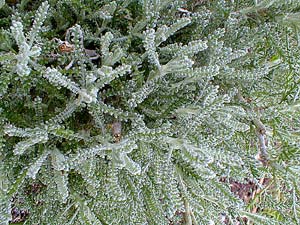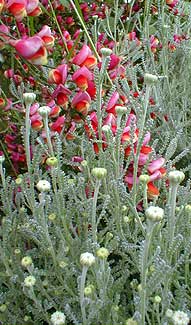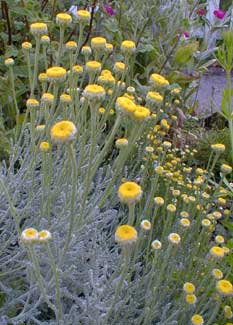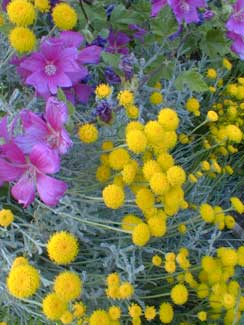
Lavender Cotton; aka,
Grey Santolina, or
The Petite Cypress
"The flower that follows the sun does so even on cloudy days."
-Robert Leighton
(1611-1684)
(1611-1684)
Some years back, Granny Artemis bought an eency tiny pot of the evergreen perennial subshrub Lavender Cotton (Santolina chamaecyparissus formerly S. incana). Because it would rarely need watering, we planted it at the foot of a yellow Lady Banks's Rose, which also requires no waterings beyond our natural rainfall.
 In that location, this native of Morocco & Spain struggled along for the next two years. It went from a tiny three-inch-round ball of cottony grey foliage to a just-under two-foot uneven ball of cotton that liked to fall over on its side. It was a terribly unattractive plant, & it barely produced any of its small chamomile-like yellow flowers.
In that location, this native of Morocco & Spain struggled along for the next two years. It went from a tiny three-inch-round ball of cottony grey foliage to a just-under two-foot uneven ball of cotton that liked to fall over on its side. It was a terribly unattractive plant, & it barely produced any of its small chamomile-like yellow flowers.Since it had never done all that well, one day I brutally hacked it back to a small size, dug it up, & banished it to a roadside sun-garden, where it immediately grew back & stood very upright & was unexpectedly very pleasing. In its first location, it was apparently just not getting enough sun, overshadowed by the Banks Rose.
 In its low-maintenance sun-garden, its nearly snowy pallidly olive-green foliage lends a marvelous contrast amidst other sun-lovers with greener leaves. It will always do best in dry calcareous or alkaline soil, & if kept too damp or in too rich a soil, it may live, but might not show itself to quite such good advantage.
In its low-maintenance sun-garden, its nearly snowy pallidly olive-green foliage lends a marvelous contrast amidst other sun-lovers with greener leaves. It will always do best in dry calcareous or alkaline soil, & if kept too damp or in too rich a soil, it may live, but might not show itself to quite such good advantage.If native soils are overall acidic (as ours are), a little lime feeding or a stick of chalk stuck into the root can be benificial; but if it generally looks pretty good, don't do anything extra for it, as it is the sort of plant that prefers neglect.
The first May (2003) photo shows the foliage without blooms. The second photo shows it with its little flowers later in May, which begin creamy white; the impressive flowers behind the lavender cotton are from a down-reaching limb of Burkwood's Broom.
 The third photo from early June shows the yellow eye of the originally white blooms, & at this stage they are very like chamomile blooms in size & appearance. The fourth late-June photo shows the mature button-flowers in bright yellow, & by now they have doubled in size & are quite showy. Throughout their long bloom time, the Burkwood's Broom has faded away for flowers, but 'Burgundy Wine' Gay mallow comes into full flower, as seen in the final photo.
The third photo from early June shows the yellow eye of the originally white blooms, & at this stage they are very like chamomile blooms in size & appearance. The fourth late-June photo shows the mature button-flowers in bright yellow, & by now they have doubled in size & are quite showy. Throughout their long bloom time, the Burkwood's Broom has faded away for flowers, but 'Burgundy Wine' Gay mallow comes into full flower, as seen in the final photo. It can be used in flower arrangements for its blue-grey textured foliage & to bring its pleasing odor into the house. But bare in mind that the flowers do not smell as pleasant as the foliage, so when used in fresh bouquets, count on taking bits of it when not in bloom.
Limbs of ferny foliage can be dried with or without flowers for use in wreathes of mixed herbs or for pillows of sweet-smelling potpourri placed in chest-of-drawers as an effective moth repellant lacking the dangerous toxicity (& disgusting odor) of mothballs.
The dried & crumbed leaves also make a pleasant spice, or can be used fresh in such dishes as barley soup. As a medicinal plant, it has been used fresh-picked to rub on insect bites to relieve the sting, or internally for upset stomach. Essential oils from the flowers & leaves have been used by perfumeries.
Folk-medcine has been taken seriously by ethnobotanists forever looking for chemical components with legitimate health value. All too often nothing pans out; controled doubleblind studies sadly reveal, time & again, that even such popular herbal remedies as echinacea, have no value beyond that of a placebo, & "popular" knowledge proves merely superstitious.
But their are signfiicant exceptions.
The genus Santolina has an unusually large number of chemical components that have held the attention of researchers especially in Mediterranean Europe & Asia Minor, where plants of this genus have long been used indiscriminately as traditional medicines. Laboratory testing indicates that the potentially active ingredients are so varied seasonally & from species to species that their indiscriminate use cannot be well founded in all cases. Its use for toxic snake-bite for instance cannot be substantiated. On the other hand, the varied constituents among various species of Santolina have shown to have dramatic potency for specific uses.
There are in particular convincing indicators that essential oils & distilates definitely function as fungicide, moth repellant, anti-inflammatory, & antibacterial activity. Voilatile oil from S. chamaecyparissus in particular has been shown to have real value in controlling Candida, according to research undertaken by Suresh et al in Tamil Nadu, India.
To keep the bush fresh & tight, it should be dramatically sheered after its summer bloom, but if sheered in spring it will not bloom that year. Sheering should refresh the shrub several years running, but eventually it may reach a point where it is always leggy, at which time it will probably need to be replaced. A new plant can be started in advance from cuttings, but they're not the easiest to start, so an inexpensive little pot from the nursery to start over is the course of least resistance.